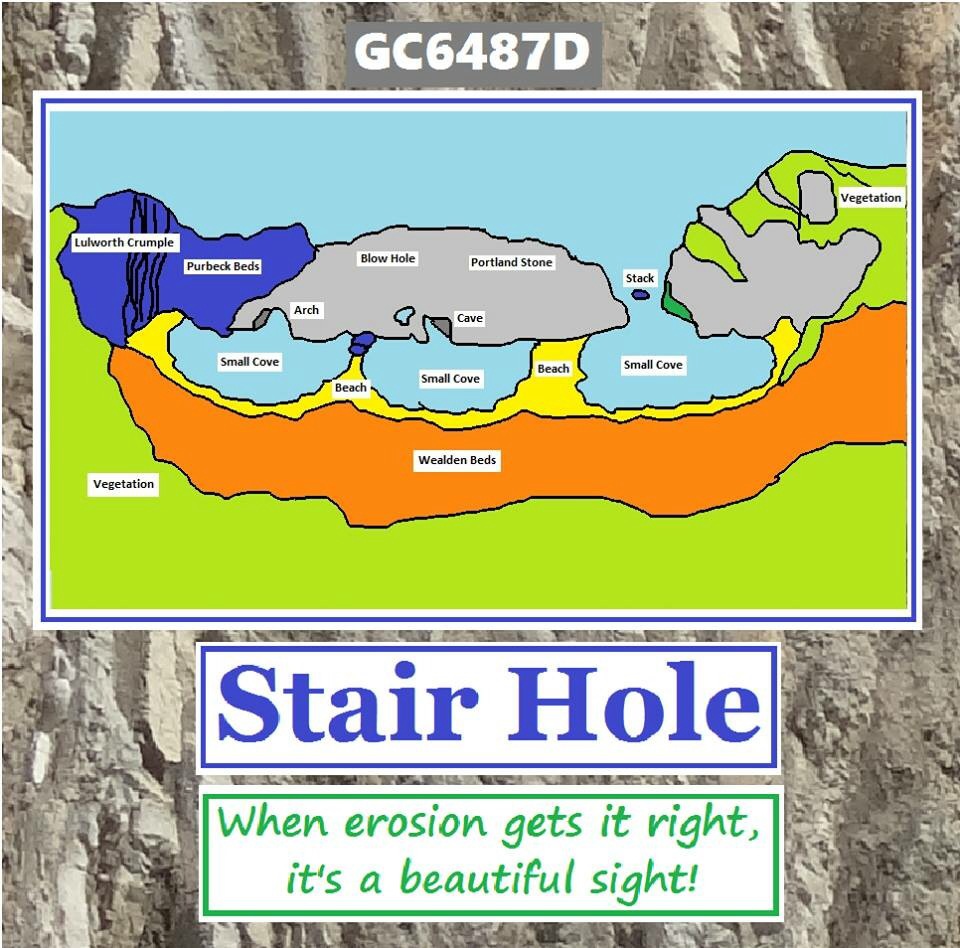
All the natural processes of coastal erosion can be seen here at Stair Hole.
There are natural cracks and fissures (joints) in the limestone (Portland Stone) that are widened by the hydraulic action of the pounding waves. Stones and rocks are picked up by the big waves and thrown against other rocks breaking them into smaller pieces. The saltwater itself can form a chemical reaction with the rocks (particularly limestone) which it breaks down. The friction of the waves wears away at the surface of the rocks. These processes are responsible for Stair Hole's unique features in the formation of a new cove.
Once the Portland Stone is breached, the waves can wash out the softer clays behind, forming the coves.
The rocks of the actual hole are made up of Jurassic Portland Limestones. Where you are stood is a mixture of clays and sandstones known as the Wealden Group.

Stair Hole shows a very good example of a fold in sedimentary rocks.
The alternations of hard limestone and soft mudstone that make up the Purbeck Beds have responded differently to the enormous pressures which formed the monoclinal fold. The limestones have fractured but have remained as almost continuous layers, whereas the mudstones have sheared and flowed to fill the intervening spaces. The sedimentary rocks around Lulworth were originally laid down horizontally, but around 30 million years ago a violent shockwave was produced when the Continents of Africa and Europe collided forming the Alps. The cross section of the Purbeck Beds found in the Eastern corner of Stair Hole demonstrates the immense pressures that were at work, forming the "Lulworth Crumple".
SAFETY FIRST! PLEASE BE CAREFUL, THE COASTAL PATH IS UNSTABLE AT THE MOMENT AND HAS SUFFERED SLIPS LOCALLY. CLIFF EDGES ARE DANGEROUS AND CARRY THE POTENTIAL TO FALL. CLIMBING IS PROHIBITED. ABIDE BY ALL SIGNS.
EarthCaches are a fun and interesting way to learn about geology. Stair Hole and Lulworth Cove on the Jurassic Coast in Dorset, are amongst the most popular geological sites visited by schools and groups. With this in mind, I have set some of the questions for this EarthCache with younger cachers in mind, who enjoy finding information and to encourage them to enjoy learning about geology.
To log this EarthCache: Go to the published Co-ordinates and answer the following questions. All answers are on the notice board, by what you can see at the coordinates or in the text on this cache page. Send your answers to me through the email / messaging service on my profile, please feel free to log before you receive a reply :
Question 1. On the East side of the Stair Hole describe the layers, which way do they dip and at what angle? (the dip of a rock is the angle it slopes into the ground)
Question 2. Stair Hole is sculpted from 3 rock types, what are they?
Question 3. Describe 2 different types of coastal erosion that can be seen here?
Question 4. List in order of the geology time line, (oldest first) the five main layers of rock that are found here?
Question 5. Stair Hole was originally a blow hole. How did this change to what you can see today?
Question 6. What do you think will happen to Stair Hole in the future?
Please share your experience and post a photo of you or the view at the GZ (optional)
Disabled Access
From the car park the ground is hard and flat developing into a steepish slope upwards. At the top of here there are about 6 steep steps down to the notice board with no hand rail. Depending on your abilities at the time, you may require assistance to get to the notice board, or have someone take a photo of it for you. If you are unable to access the notice board, please let me know. In addition to this, you should be able to see what is required to answer the questions from the top of the steps. Please feel free to contact me for further information. I am happy to help in any way I can.
There are other nearby Earthcaches. There is a Visitor Centre and Museum located at the car park where you can see rock types on display outside and learn more about fossils, geology and the history here on the Jurassic Coast, and even buy some replica fossils. There is plenty to do here to enjoy a day out for all ages and lots of designated walks. It is well worth having a look at Lulworth cove, where there is another Earthcache. You can access this from the car park to the beach edge in a wheelchair, although there is a downhill slope. Also nearby is Fossil Forest and Durdle Door where both sites have an EarthCache for those who are able to make the walk / hike up to them.
Grateful thanks to Wesley J Parks for creating the diagram and the Souvenir for this Earthcache. Many thanks also to nobby.nobbs for his inspiration and hard work in setting up the (now archived) very interesting and successful EarthCache at Lulworth Cove.

Earthcache Souvenir designed by Wesley J Parks wjp666 © With kind permission from wjp666 I will send you the HTML code to place this souvenir on your geocaching profile page when I reply confirming your your answers.